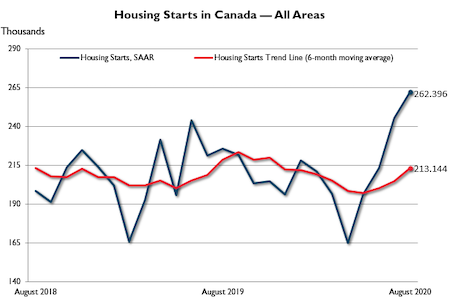Housing starts record strong August
The pace of housing starts increased again in August.
 In its latest monthly report on the annual pace of starts, Canada Mortgage and Housing Corporation revealed the national trend in starts was 213,144 units in August. That is up from 204,597 units a month previous.
In its latest monthly report on the annual pace of starts, Canada Mortgage and Housing Corporation revealed the national trend in starts was 213,144 units in August. That is up from 204,597 units a month previous.
The trend is a six-month moving average of the monthly seasonally adjusted annual rates (SAAR) of housing starts.
“The national trend in housing starts increased for a third consecutive month in August,” said Bob Dugan, CMHC's chief economist. “Higher multi-family starts in Ontario, including Toronto, drove the national increase.”
Demand for housing was strongest in Ontario which recorded a 37-percent increase in housing starts. Starts in July were just over 82,000; starts in August topped 113,000.
“To say this is a solid level of building activity considering the pandemic would be a massive understatement,” said Robert Kavcic, senior economist with BMO Economics. “As would saying that some high-profile forecasters got this one wrong. At any rate, that leaves the three-month average for starts at just over 240,000, the strongest pace since 2007.”
Demand for starts was greatest in the multi-family sector, which recorded an increase of 49 percent—to just over 92,000 for the month. Single-family starts rose by just 1 percent in the month.
Key Ontario metropolitan areas performed well in August. Starts in Ottawa rose by 134 percent, Toronto starts increased by 28 percent, Windsor starts rose by 94 percent, while starts in Kitchener-Cambridge-Waterloo increased by 16 percent.
Starts in Hamilton dropped by 50 percent, while starts in St. Catharines-Niagara dropped by 23 percent.
Helping to propel most of the increases in Ontario markets was far stronger demand for multi-family units than for single-family homes. That may be a concern, Kavacic suggests.
“Residential construction activity, typically highly cyclical, has held up remarkably well through the pandemic, and another very strong showing in August suggests that builders have fully made up any lost time during the spring,” he said. “Where we go from here is another question. Starts could ride the back of a very hot resale market (in some locations) in the near term, but could run into softer population flows and less income support over time.
Dugan added that CHMC expects national starts to trend lower by the end of 2020 as a result of the negative impact of COVID-19 on economic and housing indicators.








